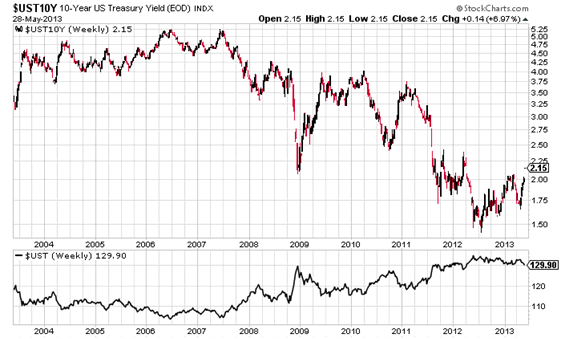Why U.S. Treasury Bonds Are Still the Worst Investment
Interest-Rates / US Bonds May 31, 2013 - 10:43 AM GMT Sasha Cekerevac writes: Savers have had a difficult time finding suitable places to allocate capital from which they can derive income. I’ve previously warned against allocating new funds to the investment strategy of U.S. Treasuries, as this would likely be the worst investment over the next decade.
Sasha Cekerevac writes: Savers have had a difficult time finding suitable places to allocate capital from which they can derive income. I’ve previously warned against allocating new funds to the investment strategy of U.S. Treasuries, as this would likely be the worst investment over the next decade.
Now, it appears that investors are increasingly coming to the same conclusion that I stated several months ago in these pages: U.S. Treasuries are set for a significant drop in price.
The investment strategy over the past couple of years for U.S. Treasuries has been built on several factors, including fear from another stock market crash and weak economic activity in the U.S.
One has to remember, there are only a few possible outcomes for U.S. Treasuries as an investment strategy. If economic growth were not to re-accelerate, the current high level of monetary stimulus could eventually lead to inflation. Considering U.S. Treasuries were yielding extremely low levels at the time I initially warned my readers, the inflation rate over the next decade would erode any yield from U.S. Treasuries.
If the Federal Reserve was successful and the U.S. economy began to rebound, investors would adjust their investment strategy and sell U.S. Treasuries—because higher interest rates would soon follow. They would also allocate capital to other assets that would have a higher expectation of return.
Only if the U.S. economy entered a period similar to Japan’s extended deflationary spiral would U.S. Treasuries outperform other assets. When creating an investment strategy, and considering the stated intent by the Federal Reserve to prevent such a deflationary spiral, the investment strategy of simply buying U.S. Treasuries for the long term made no sense to me.
With recent data showing some improvement in the economy, such as the Bloomberg Consumer Comfort Index being at its highest level in five years and higher real estate and stock prices, investors are realizing that there is potential for the economy to improve. (Source, Jamrisko, M., “Confidence Improves as U.S. Consumers’ Views on Economy Mend,” Bloomberg, May 23, 2013, accessed May 29, 2013.)
This has resulted in the highest yield for U.S. Treasuries in over a year. As I stated several months ago, investing in U.S. Treasuries at that point would result in significant losses.
Below is a chart showing the price of 10-year U.S. Treasuries from 2004 to today:

Chart courtesy of www.StockCharts.com
In this chart, the corresponding interest rate appears to indicate that the long-term move upward in the price of U.S. Treasuries is in the process of being broken, with interest rates set to rise.
This could create significant headwinds for the U.S. economy. Since much of the economy is rebounding based on interest rate–sensitive sectors, such as the housing and automobiles sectors, an increase in interest rates could slow the healing process.
Frankly, it is more a question of speed of ascent than direction. Broadly speaking, the current level of U.S. Treasuries is abnormally low, and we do need some normalization. However, if rates move up too quickly, that would be extremely harmful to both the economy and the stock market.
Stocks, I believe, are vulnerable to a sell-off based on higher interest rates, even if the economy improves. This is because many people use the dividend yield as part of their investment strategy to create income. Additionally, when creating a model on valuation, one has to use the prevailing interest rate. If rates increase, this will have a negative effect on stock valuations.
I think it is obvious that stocks are primarily dividend-yielding and have no level of growth, and so they will be hurt and should be pared back in one’s investment strategy. Additionally, I still believe that U.S. Treasuries are a poor place in which to invest over the next few years.
By Sasha Cekerevac, BA
www.investmentcontrarians.com
Investment Contrarians is our daily financial e-letter dedicated to helping investors make money by going against the “herd mentality.”
About Author: Sasha Cekerevac, BA Economics with Finance specialization, is a Senior Editor at Lombardi Financial. He worked for CIBC World Markets for several years before moving to a top hedge fund, with assets under management of over $1.0 billion. He has comprehensive knowledge of institutional money flow; how the big funds analyze and execute their trades in the market. With a thorough understanding of both fundamental and technical subjects, Sasha offers a roadmap into how the markets really function and what to look for as an investor. His newsletters provide an experienced perspective on what the big funds are planning and how you can profit from it. He is the editor of several of Lombardi’s popular financial newsletters, including Payload Stocks and Pump & Dump Alert. See Sasha Cekerevac Article Archives
Copyright © 2013 Investment Contrarians - All Rights Reserved Disclaimer: The above is a matter of opinion provided for general information purposes only and is not intended as investment advice. Information and analysis above are derived from sources and utilising methods believed to be reliable, but we cannot accept responsibility for any losses you may incur as a result of this analysis. Individuals should consult with their personal financial advisors.
Investment Contrarians Archive |
© 2005-2022 http://www.MarketOracle.co.uk - The Market Oracle is a FREE Daily Financial Markets Analysis & Forecasting online publication.



